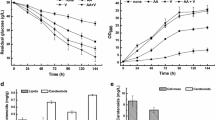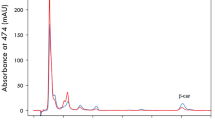Abstract
Mutagenic treatment with N-methyl-N′-nitro-N-nitrosoguanidine (MNNG) inPhaffia rhodozyma generated 15 mutants with a wide diversity of color variants ranging from white to dark red. Characterization of the mutants by absorption spectra, TLC and HPLC was performed. Two categories could be distinguished: astaxanthin hyperproducing and astaxanthin hypoproducing mutants. Hyperproducing mutants exhibited considerable increases in astaxanthin content whereas hypoproducing mutants showed higher β-carotene contents than the wild-type strain. The characterization of carotenoid mutants inP. rhodozyma could contribute to the knowledge of the biosynthetic pathway of astaxanthin production of this microorganism.
Similar content being viewed by others
References
An G.-H., Schuman D.B., Johnson E.A.: Isolation ofPhaffia rhodozyma mutants with increased astaxanthin content.Appl. Environ. Microbiol. 55, 116–124 (1989).
Britton G.: General carotenoid methods.Methods Enzymol. 111, 113–149 (1985).
Calo P., Velázquez J.B., Sieiro C., Blanco P., Longo E., Villa T.G.: Analysis of astaxanthin and other carotenoids from severalPhaffia rhodozyma mutants.J. Agric. Food Chem. 43, 1396–1399 (1995).
Girard P., Falconnier B., Bricout J., Vladescu B.: β-Carotene producing mutants ofPhaffia rhodozyma.Appl. Microbiol. Biotechnol. 41, 183–191 (1994).
Johnson E.A., An G.-H.: Astaxantin from microbial sources.CRC Crit. Rev. Biotechnol. 11, 297–326 (1991).
Johnson E.A., Schroeder W.A.: Microbial carotenoids.Adv. Biochem. Eng. 53, 119–178 (1995).
Lawrence C.W.: Classical mutagenesis techniques, Vol. 194, pp. 273–281 in C. Guthrie, G.F. Fink (Eds):Methods in Enzymology, Guide to Yeast Genetics and Molecular Biology. Academic Press, San Diego 1991.
Meyer P.S., Du Preez J.C.: Photo-regulated astaxanthin production byPhaffia rhodozyma mutants.System. Appl. Microbiol. 17, 24–31 (1994).
Phaff H.J., Miller M.W., Yoneyama M., Soneda M.: A comparative study of the yeast florae associated with trees on Japanese Islands and on the west coast of North America, pp. 759–774 in G. Teru (Ed.):Proceedings IV IFS: Fermentation Technology Today. Society of Fermentation Technology, Osaka 1972.
Schroeder W.A., Johnson E.A.: Carotenoids protectPhaffia rhodozyma against singlet oxygen damage.J. Ind. Microbiol. 14, 502–507 (1995).
Sedmak J.J., Weerasinghe D.K., Jolly S.O.: Extraction and quantitation of astaxanthin fromP. rhodozyma.Biotechnol. Techn. 4, 107–112 (1990).
Author information
Authors and Affiliations
Rights and permissions
About this article
Cite this article
Rubinstein, L., Altamirano, A., Santopietro, L.D. et al. Isolation and characterization ofPhaffia rhodozyma mutants. Folia Microbiol 43, 626–630 (1998). https://doi.org/10.1007/BF02816380
Received:
Issue Date:
DOI: https://doi.org/10.1007/BF02816380




